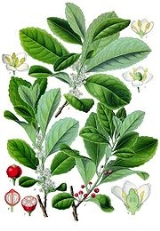
Aquifoliales
Encyclopedia
The Aquifoliales are an order of flowering plant
s, including most notably the Aquifoliaceae, or holly
family, and also the Helwingiaceae (2-5 species of temperate Asia
n shrub
s) and the Phyllonomaceae
(4 species of Central America
n tree
s and shrub
s). In 2001, the families Stemonuraceae and Cardiopteridaceae
were added to this order. This circumscription
of Aquifoliales was recognized by the Angiosperm Phylogeny Group
when they published the APG II system
in 2003. In the Cronquist system
, there is no Aquifoliales order: the Aquifoliaceae are placed within the order Celastrales
and the others are in other families.
Flowering plant
The flowering plants , also known as Angiospermae or Magnoliophyta, are the most diverse group of land plants. Angiosperms are seed-producing plants like the gymnosperms and can be distinguished from the gymnosperms by a series of synapomorphies...
s, including most notably the Aquifoliaceae, or holly
Holly
Ilex) is a genus of 400 to 600 species of flowering plants in the family Aquifoliaceae, and the only living genus in that family. The species are evergreen and deciduous trees, shrubs, and climbers from tropics to temperate zones world wide....
family, and also the Helwingiaceae (2-5 species of temperate Asia
Asia
Asia is the world's largest and most populous continent, located primarily in the eastern and northern hemispheres. It covers 8.7% of the Earth's total surface area and with approximately 3.879 billion people, it hosts 60% of the world's current human population...
n shrub
Shrub
A shrub or bush is distinguished from a tree by its multiple stems and shorter height, usually under 5–6 m tall. A large number of plants may become either shrubs or trees, depending on the growing conditions they experience...
s) and the Phyllonomaceae
Phyllonomaceae
The family Phyllonomaceae is a family of dicotyledons, consisting of 4 species of trees and shrubs in the genus Phyllonoma. They are native to Central America ....
(4 species of Central America
Central America
Central America is the central geographic region of the Americas. It is the southernmost, isthmian portion of the North American continent, which connects with South America on the southeast. When considered part of the unified continental model, it is considered a subcontinent...
n tree
Tree
A tree is a perennial woody plant. It is most often defined as a woody plant that has many secondary branches supported clear of the ground on a single main stem or trunk with clear apical dominance. A minimum height specification at maturity is cited by some authors, varying from 3 m to...
s and shrub
Shrub
A shrub or bush is distinguished from a tree by its multiple stems and shorter height, usually under 5–6 m tall. A large number of plants may become either shrubs or trees, depending on the growing conditions they experience...
s). In 2001, the families Stemonuraceae and Cardiopteridaceae
Cardiopteridaceae
Cardiopteridaceae is a eudicot family of flowering plants. It consists of about 43 species of trees, shrubs, and woody vines, mostly of the tropics, but with a few in temperate regions. It contains six genera, the largest of which is Citronella, with 21 species. The other genera are much smaller...
were added to this order. This circumscription
Circumscription (taxonomy)
In taxonomy, circumscription is the definition of the limits of a taxonomic group of organisms. One goal of taxonomy is to achieve a stable circumscription for every taxonomic group. Achieving stability can be simple or difficult....
of Aquifoliales was recognized by the Angiosperm Phylogeny Group
Angiosperm Phylogeny Group
The Angiosperm Phylogeny Group, or APG, refers to an informal international group of systematic botanists who came together to try to establish a consensus on the taxonomy of flowering plants that would reflect new knowledge about plant relationships discovered through phylogenetic studies., three...
when they published the APG II system
APG II system
The APG II system of plant classification is the second, now obsolete, version of a modern, mostly molecular-based, system of plant taxonomy that was published in April 2003 by the Angiosperm Phylogeny Group. It was a revision of the first APG system, published in 1998, and was superseded in 2009...
in 2003. In the Cronquist system
Cronquist system
The Cronquist system is a taxonomic classification system of flowering plants. It was developed by Arthur Cronquist in his texts An Integrated System of Classification of Flowering Plants and The Evolution and Classification of Flowering Plants .Cronquist's system places flowering plants into two...
, there is no Aquifoliales order: the Aquifoliaceae are placed within the order Celastrales
Celastrales
Celastrales is an order of flowering plants. They are found throughout the tropics and subtropics, with only a few species extending far into the temperate regions. There are about 1200 to 1350 species in about 100 genera. All but 7 of these genera are in the large family Celastraceae...
and the others are in other families.

